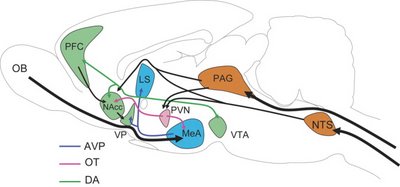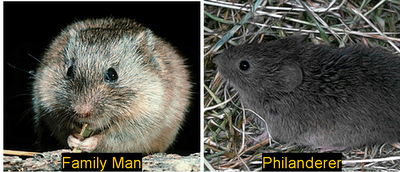Studies over about a decade have shown that oxytocin and vasopressin, peptides secreted in the brain, are involved in the formation and regulation of various social behaviors. For example, oxytocin is released in females during nipple stimulation when a child is suckling, which in many species is important in strengthening the mother-infant bond. Interestingly, vasopressin and oxytocin are also released into the blood during orgasm in humans.
The graphic below illustrates the current understanding of neural circuitry regulating pair bond formation (1). (This represents a vole brain, hence the unfamiliar shape.)
In the authors’ words:…at least three separate, yet interconnected neural circuits converge to yield the development of the pair bond. Circuits involved in the processing of social cues and formation of social memory [blue regions] are tightly coupled with the brain’s reward and reinforcement circuitry [green regions]. These two circuits are modulated by…circuits conveying somatosensory information from the genitalia during sexual interactions [brown regions]. The interaction of these pathways during sex culminate in the development of a powerful association between [sex] and the [the partner] to form the conditioned “partner” preference, or pair bond.
It is unknown whether similar circuitry exists in humans, and there are expected differences. In voles, for example, olfactory clues are important, whereas in humans the role of smell is probably replaced by higher cerebral (thought) activity.
What does that mean in English?
In overly simplified terms: Two voles, named Mike and Megan, mate; the next time Mike smells Megan, Mike’s brain remembers the reward of being with Megan, and vice versa; Jenny does not evoke the same good memories in Mike, so Jenny is ignored. Ahhh, the smell of monogamy!
What does this have to do with genes?
Dr Larry J Young, an associate professor at Emory University, recently reviewed his work in this area at The Endocrine Society Meeting in Boston, Massachussetts. Dr Young uses prairie voles as a model of pair bonding. Prairie voles are particularly useful because they form lifelong mating pairs and the male and female contribute equally to caring for the young—unlike other voles in the same genus (like the montane vole) or other rodents. Dr Young has found that one difference between monogamous prairie voles and promiscuous montane voles is in the distribution of vasopressin and oxytocin receptors in the brain. His hypothesis is that if the receptors are not expressed in certain areas, then smell and sex will no longer coordinate to form social memory. Hence, when a montane vole mates, it does not form a lasting bond with its partner and is therefore unrestrained when encountering a different potential mate. (This hypothesis is strongly supported by a wealth of pharmacological and genetic data, which I won’t go into—unless asked.)
Dr Young has found that one difference between monogamous prairie voles and promiscuous montane voles is in the distribution of vasopressin and oxytocin receptors in the brain. His hypothesis is that if the receptors are not expressed in certain areas, then smell and sex will no longer coordinate to form social memory. Hence, when a montane vole mates, it does not form a lasting bond with its partner and is therefore unrestrained when encountering a different potential mate. (This hypothesis is strongly supported by a wealth of pharmacological and genetic data, which I won’t go into—unless asked.)
What makes the difference?
The reason for the differences in receptor expression appear to be due to a repetitive sequence in the vasopressin receptor gene. Males with longer repeats (called microsatellites) show “more paternal care and are more likely to form a pair bond than males with shorter microsatellites” (2). Humans also show a high degree of diversity in microsatellite length in the vasopressin receptor gene. The implication for human behavior is obvious: this could explain some of the diversity in human behavior, particularly the quality of paternal care and fidelity of husbands.
______________________________________________
1. Young LJ, et al., J Comparative Neur 493:51-57
2. Young LJ. Oxytocin, Vasopressin & Social Bonding. 88th Annual Meeting of the Endocrine Society, Boston, MA, June 2006.
03 August 2006
The Monogamy Gene
Subscribe to:
Post Comments (Atom)
3 comments:
Try telling the bishop that you are genetically predisposed to cheating on your wife and that he needs to understand.
Whether our temptations are exacerbated by nurture or nature, we are instructed to withstand them. God will take into account the extenuating circumstances. After all, he is the only one who is aware of all the variables.
Interesting post. I know very little about neuroscience--something I hope to remedy at some point.
I know that the concept of pheremones is controversial in humans; apparently there is little support for it. But I have no problem believing that literal chemistry plays an important role at several levels in forming relationships.
Wonderdog: Actually, that's exactly the sort of thing a bishop should take into account. Perhaps I'll post later on this.
Jared: My degree of proficiency in neuroscience is being able to find good things to put into blockquotes. One of the points Dr Young has made is how surprised he was to find that something expected to be complex could be controlled by "literal chemistry," as you put it.
Post a Comment